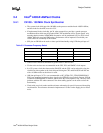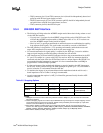
Intel
®
440GX AGPset Design Guide
3-13
Design Checklist
— TMS (connector pin A3) and TDI (connector pin A4) should be independently bussed and
pulled up with 5K ohm (approximate) resistors.
— TRST# (connector pin A1) and TCK (connector pin B2) should be independently bussed
and pulled down with 5K ohm (approximate) resistors.
— TDO (connector pin B4) should be left open.
3.5.4 82443GX AGP Interface
•
The following will help reduce the AGPREF margin needed when data is being written or read
via the AGP bus interface.
— Use only two 1% resistors for the AGPREF voltage divider on the 82443GX boards. This
will limit the AGPREF margin needed to 100mV below 40% of Vcc. If 5% resistors are
used, the AGPREF margin needed would be 160mV.
— Have “at least” 2x spacing around Strobe A and B to decrease crosstalk inductive coupling
from adjacent GAD signals. This could reduce crosstalk by as much as 100-300 mV.
•
The AGP interface is designed for a 3.3V operating environment, and both the master and
target AGP compliant devices must be driven by the same supply line.
•
No external termination for signal quality is required by the AGP spec., but can be added to
improve signal integrity provided the timing constraints are still satisfied.
•
AGP interrupts may be shared with PCI interrupts similar to the recommendations in the PCI
2.1 spec. For example, in a system with 3 PCI slots and one AGP slot, interrupts should be
connected such that each of the four INTA# lines hooks to a unique input on the PIIX4E. It is
recommended that the interrupts be staggered. It is also recommended that each PIRQ be
programmed to a different IRQ if possible.
•
It is the requirement of the motherboard designer to properly interface the AGP interrupts to
the PCI bus. In this reference design, the AGP interrupts are pulled up to 3.3V, and a buffer is
used to isolate the 5V environment from the AGP bus.
•
To minimize the impact of any mismatch between the motherboard and the add-in card, a
board impedance of 65 ±15 ohms is strongly recommended.
•
At each component that requires it, AGP_Vref should be generated locally from the AGP
interface Vddq rail.
NOTES:
1. MAB[9]# is connected to internal 50K ohm pull-down resistors. MAB[12:11] are connected to internal 50K
ohm pull-up resistors.
2. Note that strapping signals are not driven by the 82443GX during reset sequence. Proper strapping must be
used to define logical values for these signals. Default values provided by the internal pull-up or pull-down
resistors can be overridden by an external resistor.
3. When AGP is disabled, all AGP signals are tri-stated and isolated. They do not need external pull-up
resistors. The AGP signals are PIPE#, SBA[7:0], RBF#, ST[2:0], GADSTBA, GADSTBB, SBSTB, GFRAME#,
GIRDY#, GTRDY#, GSTOP#, GDEVSEL#, GREQ#, GGNT#, GAD[31:0], FC/BE[3:0]#, GPAR.
4. When AGP is disabled, tie AGP_Vref to ground.
Table 3-5. Strapping Options
Signal Description Register Pulled to ‘0’ Pulled to ‘1’
MAB9# AGP Signals PMCR[1] AGP Enabled (Default) AGP Disabled
MAB11#
In Order Queue
Depth
MGXCFG[2] Non-Pipelined
Maximum Queue Depth
Enabled (Default)
MAB12# Host Frequency NGXCFG[13] Reserved 100MHz (Default)


















